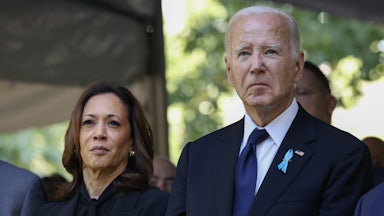President Donald Trump has reasserted his ostensible support for policies that conservative proponents believe will encourage parents to have more children, within a “pronatalist” framework that has been embraced by the likes of Vice President JD Vance and billionaire Elon Musk. Some of these policies incorporate an economic element, such as a one-time payment upon the birth of a child that some conservatives hope would incentivize married couples to have children.
But while it’s uncertain whether such policies would fulfill the explicit pronatalist objective of countering the falling American birth rate sought by the administration and its allies, they could have a significant economic impact by helping to alleviate the high costs of raising children in the United States. Leah Sargeant, a senior analyst for social policy at the Niskanen Center who recently wrote a report exploring the benefits of a $2,000 baby bonus, argued that the support it would offer to families is more relevant than questions of increasing fertility rates.
“What it’s intended to do is to get families who want a baby more of a reason they feel they can sustain the risk,” said Sargeant. “Having a baby is always opting into uncertainty, and the goal is to make it feel like you’re a little more stable to handle the tougher end of the spectrum of what could happen.”
Child-rearing in the United States is expensive, from the price of a hospital childbirth to increasingly high childcare costs. Moreover, unlike other developed countries, the United States does not have a paid family leave program. The expenses continue to add up through childhood: One recent study found that raising a child through age 18 costs parents roughly $300,000. A one-time payment of $5,000, of the sort that Trump proposed on the campaign trail, is not sufficient to single-handedly alleviate the economic shocks of childbearing.
However, this kind of grant could still be a significant boost for new parents at a particularly vulnerable period. One recent study found that poverty rates increase by roughly one-third in the first month of childhood, a trend particularly affecting Black, Latina, and first-time mothers. Poverty in early childhood can have significant negative consequences, as poor children may have lower cognitive development, as well as worse health and educational outcomes, than their higher-income peers.
A federal grant given to new parents upon birth could help absorb the economic shocks and dramatically reduce poverty rates in that first month of childhood. One 2023 study found that a $1,800 baby bonus would cut the poverty rate among mothers of newborns from roughly 26 percent to under 3 percent in the month of birth. That decrease would be even more significant if it was paired with a monthly expanded child tax credit, akin to what was temporarily implemented for six months in 2021.
While useful, a baby bonus should not be considered a replacement for other proposals to offer support to families, said Megan Curran, director of policy at the Center on Poverty and Social Policy at Columbia University. “Where it starts to get a little bit more problematic is if it’s assuming that can be the only policy in place,” she said.
Moreover, when considering ways to encourage a higher birth rate through financial incentives, some conservatives believe an expanded child tax credit may be a more effective policy to provide economic certainty, which may in turn grant families the cushion to have more children.
“I think a baby bonus would be nice. It would be lovely to have one, but a one-time payment in the year of birth is not, I think, a credible pathway to long-term stabilization of family incomes,” said Lyman Stone, director of the Pronatalism Institute at the Institute for Family Studies.
The first Trump administration did oversee a significant expansion of the child tax credit, which was approved as part of his massive 2017 tax cuts legislation. That measure doubled the credit, increased the portion of the credit that is refundable, and raised the earning threshold of the credit’s phaseout. However, under that policy, families need to have an annual earned income of $2,500 to qualify for the full credit; because of this requirement, 25 percent of all children under age 17 were ineligible for the full credit in 2023.
A baby bonus could help adjust for some of the issues with the current child tax credit. Because the credit is received in a lump sum during tax filing season, it benefits families with children born later in the year. For example, the parents of a child born in December 2025 would receive the child tax credit payment only a few months after birth, in early spring of 2026. But the parents of a child born in January 2025 would need to wait more than a year before claiming the credit.
If a baby bonus were structured to be a stand-alone benefit granted closer to a child’s birth, it would sidestep that timing issue. “If you want things to be easier for parents when they’re undergoing that income shock, you want the money to come right when the baby is born,” said Sargeant.
The efficacy of a baby bonus would also depend on whether it is subject to the same eligibility requirements as the current child tax credit—which would exclude the lowest-income families from receiving the full bonus along with the full credit.
“If you’re tying some kind of baby payment under the same criteria, then it’s questionable the degree to which it’s going to be helpful,” said Curran. “I think probably families would always welcome flexible cash, especially around that time, but you definitely wouldn’t see the same type of impact … in terms of keeping child poverty really, really low during the first year of life and moving forward.”
The first Trump-era expansion of the child tax credit is set to expire at the end of this year, and congressional Republicans are looking to act before that deadline with a massive bill to extend the 2017 tax cuts and dramatically slash government spending. However, that measure—which needs to pass through an arcane process called “reconciliation” to avoid the 60-vote threshold for approving legislation in the Senate—is still being written, and it’s unclear what the final product will look like.
Stone believes that the child tax credit could be bigger—“however large Congress has the stomach to find pay-fors for,” to be specific—and thinks that eligibility could be expanded by lowering the income threshold, while still tying it to work by connecting the credit to payroll taxes. But he pushed back against Republican critics who might see expanding the child tax credit as creating a welfare state.
“This is not a welfare program. It literally phases in with income, not out. That’s true even if you expand the refundability by some margin,” Lyman argued.
There is some appetite for bipartisan expansion of a child tax credit in Congress; the Republican-led House approved a measure crafted by GOP and Democratic lawmakers increasing the credit amount last year, although it was torpedoed by Republicans in the Senate. Democrats and Republicans have also separately expressed support for one-time baby bonuses, although there is a difference in the primary motivation behind implementing them: supporting a policy that makes child-rearing more affordable with the underlying goal of encouraging traditional family formation for conservatives, or as a method of reducing child poverty for progressives.
In the wake of the Supreme Court’s overturning of Roe v. Wade in 2022, some abortion opponents have expressed support for economic policies that they argue would encourage people to have children. This could further incentivize Republicans to support a one-time federal grant at birth. Sargeant noted that women who seek abortions are often low-income and already have a child at home.
“Anything that can cushion that impact of a baby in that first year, I think, is attractive to Republicans who prioritize pro-life concerns, and I think it can be a real priority for Democrats as well, who want to retain abortion access but also want to make sure moms have reproductive justice and support when they want to have the kid they’ve conceived,” said Sargeant.
But even if Republicans included some kind of baby bonus along with an extension of the current child tax credit in the reconciliation bill—whether it is increased or remains largely static—it still raises questions about how helpful such a policy would actually be. GOP lawmakers are mulling dramatic cuts to Medicaid and the Supplemental Nutrition Assistance Program, also known as food stamps, which would affect the low-income children who might otherwise benefit from such policies. Moreover, the Trump administration has gutted programs related to maternal health and reproductive medicine, raising questions about the depths of his commitment to making having a child easier.
“A one-time baby bonus is not going to be able to cover health care that they might lose, or cover food bills for the family,” said Curran.










